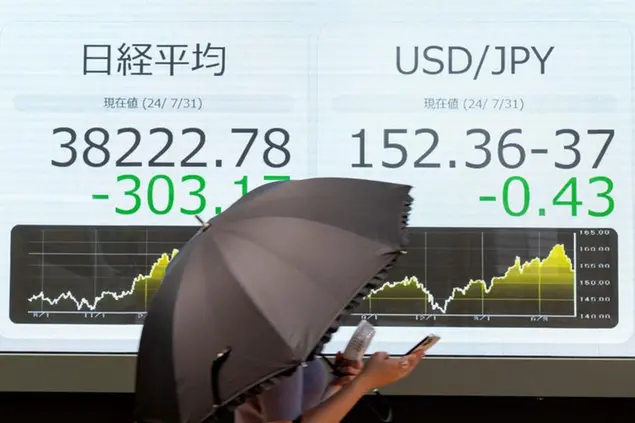PHOTO
SYDNEY/LONDON - Stock markets tumbled on Monday, with Japanese shares at one point exceeding their 1987 "Black Monday" loss, as fears of a U.S. recession sent investors fleeing from risk while wagering that rate cuts would be needed to rescue growth.
The safe haven yen and Swiss franc surged, as crowded carry trades unravelled, sparking speculation that some investors were unloading profitable trades to get money to cover losses elsewhere. Such was the torrent of selling that circuit breakers were triggered on stock exchanges across Asia.
Japan's benchmark Nikkei average closed 12.40% lower at 31,458.42, its largest one-day fall since October 1987, while the broader Topix lost 12.48% to 2,220.91.
European stocks opened 1.8% lower with France's CAC 40 down 2.1%, Spain's IBEX down 2.8% the UK's FTSE 100 off 1.7% on fears of a global recession after weak U.S. data.
Treasury bonds were in demand, with U.S. 10-year yields hitting 3.723%, the lowest since mid-2023 after rising back to 3.737.
A worryingly weak July payrolls report on Friday saw markets price in a 78% chance the Federal Reserve will not only cut rates in September, but ease by a full 50 basis points. Futures imply 122 basis points of cuts in the 5.25-5.5% funds rate this year, and rates of around 3.0% by the end of 2025. "We have increased our 12-month recession odds by 10pp to 25%," said analysts at Goldman Sachs in a note, though they thought the danger was limited by the sheer scope the Fed had to ease policy.
Goldman now expects 25 bp cuts in September, November, and December.
"The premise of our forecast is that job growth will recover in August and the FOMC will judge 25 bp cuts a sufficient response to any downside risks," they added. "If we are wrong and the August employment report is as weak as the July report, then a 50bp cut would be likely in September."
Analysts at JPMorgan were even more bearish, assigning a 50% probability to a U.S. recession.
"Now that the Fed looks to be materially behind the curve, we expect a 50 bp cut at the September meeting, followed by another 50 bp cut in November," said economist Michael Feroli.
"Indeed, a case could be made for an inter-meeting easing, especially if the data soften further — although Fed officials might worry about how such a move could be (mis)interpreted."
SEEKING SAFE HARBOURS
Investors will get a read on employment in the service sector from the ISM non-manufacturing survey later on Monday and analysts are expecting a rebound to 51.0 after June's unexpected slide to 48.8.
This week has earnings from industrial bellwether Caterpillar and media giant Walt Disney, which will give more insight into the state of the consumer and manufacturing. Also reporting are healthcare heavyweights such as weight-loss drugmaker Eli Lilly.
The huge drop in Treasury yields had also overshadowed the U.S. dollar's usual safe-haven appeal and dragged the greenback down 0.4% against a basket of other major currencies.
The dollar fell by as much as 3.28% against the Japanese yen to 141.675, while the euro dived 2.12% to 156.46 . The single currency rose against the dollar to $1.0929.
The Swiss franc was a major beneficiary of the rush from risk, with the dollar falling 1.07% and hovering at six-month lows of 0.8485 francs.
"The shift in expected interest rate differentials against the U.S. has outweighed the deterioration in risk sentiment," said Jonas Goltermann, deputy chief markets economist at Capital Economics.
"If the recession narrative takes hold in earnest, we would expect that to change, and the dollar to rebound as safe-haven demand becomes the dominant driver in currency markets."
Investors have also increased wagers other major central banks will ease more aggressively, with the European Central Bank now seen cutting by 67 basis points by Christmas.
In commodity markets, gold lost some of its safe haven appeal, down 0.5% at $2,431 an ounce.
Oil prices eased as concerns about global energy demand offset worries about the potential impact to supply from a widening conflict in the Middle East.
Brent fell 64 cents to $76.17 a barrel, while U.S. crude lost 65 cents to $72.87 per barrel.
(Reporting by Nell Mackenzie and Wayne Cole; Editing by Amanda Cooper, Stephen Coates and Shri Navaratnam, Kirsten Donovan)
